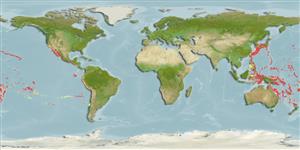>
Acropomatiformes (Oceanic basses) >
Symphysanodontidae (Slopefishes)
Etymology: Symphysanodon: Greek, syn, symphysis = grown together + Greek, physis = growth body form + Greek, odous = teeth; related to few teeth which are located over the area where the two jaws meet (Ref. 45335).
Environment: milieu / climate zone / depth range / distribution range
البيئة
بحري قاعية التغذية و المعيشة; نطاق العمق 131 - 705 m (Ref. 54833), usually 150 - 500 m (Ref. 54833). Tropical; 38°N - 37°S, 119°E - 72°W
Pacific Ocean: off Japan and Lombok, Indonesia to the Hawaiian Islands and Sala y Gómez Ridge.
الحجم / وزن / العمر
Maturity: Lm ? range ? - ? cm
Max length : 16.0 cm SL ذكر/ مختلط الجنس; (Ref. 9831); common length : 9.0 cm SL ذكر/ مختلط الجنس; (Ref. 9831)
This species is frequently consumed by the lutjanid Pristipomoides zonatus at Pathfinder Reef, Mariana Archipelago (Ref. 9831).
Life cycle and mating behavior
Maturities | التكاثر | Spawnings | Egg(s) | Fecundities | Larvae
Anderson, W.D. Jr., 1999. Symphysanodontidae. Bunquelovelies (also wampeejawed fishes, slopefishes, and shelf beauties). p. 2438-2441. In K.E. Carpenter and V.H. Niem (eds.) FAO species identification guide for fishery purposes. The living marine resources of the Western Central Pacific. Volume 4. Bony fishes part 2 (Mugilidae to Carangidae). FAO, Rome. (Ref. 9831)
IUCN Red List Status (Ref. 130435)
استخدامات بشرية
أدوات
تقارير خاصة
Download XML
مصادر علي الأنترنت
Estimates based on models
Preferred temperature (Ref.
123201): 7 - 19.9, mean 12.6 °C (based on 400 cells).
Phylogenetic diversity index (Ref.
82804): PD
50 = 0.5004 [Uniqueness, from 0.5 = low to 2.0 = high].
Bayesian length-weight: a=0.00407 (0.00156 - 0.01065), b=3.11 (2.88 - 3.34), in cm total length, based on LWR estimates for this (Sub)family-body shape (Ref.
93245).
مستوى غذائي (Ref.
69278): 3.5 ±0.5 se; based on size and trophs of closest relatives
Fishing Vulnerability (Ref.
59153): Low vulnerability (10 of 100).
